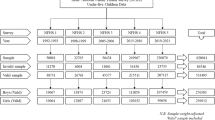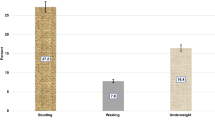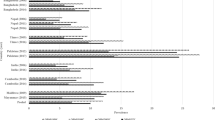Abstract
Objectives:
To identify socioeconomic, demographic and environmental factors that predict undernutrition in adults in a Dhaka slum population.
Design:
A panel survey, conducted between 1995 and 1997. A random sample of households was selected. Socioeconomic, demographic and environmental variables were collected monthly by questionnaire and nutritional status was assessed.
Setting:
Dhaka slums in Bangladesh.
Subjects:
A total of 1097 adults surveyed during September–December 1996.
Main outcome measures:
Body mass index (BMI) less than 18.5 kg/m2.
Results:
There was a sex difference with female subjects having a significant odds ratio for low BMI compared with male subjects (P<0.03). There was no difference by age for males, but there was a difference by age for female subjects, with women aged 30–39 and 40–49 years having the worst BMI (P<0.04; P<0.04). The Beri Bahd area of residence had the worst BMI (P<0.001). Deficit situation as the self-reported financial situation had the worst BMI (P<0.03). Casual wage workers, unskilled and dependent self-employed individuals had the worst BMI (P<0.005; P<0.003). Not being involved in credit organizations and NGO credit organizations was associated with worst BMI (P<0.008; P<0.03). Those households that had an income of 2000–2499 Taka had the worst BMI (P<0.07). Households with a floor area of 5 m2 or more per consumption unit had the best BMI (P<0.01). Households without electricity had the worst BMI (P<0.007). Households with tube well water had the worst BMI compared with those with tap water (P<0.001).
Conclusions:
Under nutrition was related to demographic, economic, social and environmental factors.
Sponsorship:
University College, London.
This is a preview of subscription content, access via your institution
Access options
Subscribe to this journal
Receive 12 print issues and online access
$259.00 per year
only $21.58 per issue
Buy this article
- Purchase on Springer Link
- Instant access to full article PDF
Prices may be subject to local taxes which are calculated during checkout
Similar content being viewed by others
References
ACC/SCN (2000). Fourth Report on the World Nutrition Situation. ACC/SCN in collaboration with IFPRI: Geneva.
Branca F, Abdulle A (1993). Famine in Somalia (letter). Lancet 341 (8853), 1478.
Delpeuch F, Traissac P, Martin-Prevel Y, Massamba JP, Maire B (2000). Economic crisis and malnutrition: socioeconomic determinants of anthrometric status of preschool children and their mothers in an African urban area. Public Health Nutrtion 3 (1), 39–47.
Food and Agriculture Organisation (1992) World Health Organisation International Conference on Nutrition, Final Report, Rome, Italy, pp 9–55.
Government of Bangladesh (1992). Report of the Task Forces on Bangadesh Development Strategies for the 1990's, vol. 3 Developing the Infrastructure. Government of Bangladesh: Dhaka.
Government of Bangladesh (1996) Bangladesh Integrated Nutrition Project. Project Implementation Volume (PIV). Bangladesh: Ministry of Health and Family Welfare, Government of Bangladesh. pp 1–94.
Government of Bangladesh (1997) Bangladesh National Food and Nutrition Policy. Bangladesh: Ministry of Health and Family Welfare, Government of Bangladesh. pp 1–25.
Hakeem R (2001). Socio-economic differences in height and body mass index of children and adults living in urban areas of Karachi, Pakistan. Eur J Clin Nutr 55 (5), 400–406.
Islam N (ed). (1997). Addressing the urban poverty agenda in Bangladesh. Asian Development Bank/University Press Ltd: Dhaka.
Kennedy N, Ramsay A, Uiso L, Gutmann J, Ngowi FI, Gillespie SH (1996). Nutritional status and weight gain in patients with pulmonary tuberculosis in Tanzania. Trans Roy Soc Trop Med Hygiene 90 (2), 162–166.
Nube M, Aseno-Okyere WR, Van den Boom GJ (1998). Body mass index as an indicator of living in developing countries. Eur J Clin Nutr 52 (2), 136–144.
Pryer JA (1990). Socio-economic and environmental aspects of Undernutrition and ill-health in an urban slum in Bangladesh, PhD Thesis, University of London.
Pryer JA (1993). Nutritionally vulnerable households in the urban slum economy: a case study from Khulna, Bangladesh. In: Schell LM, Smith MT, Bilsborough A (eds). Urban Ecology and Health in the Third World. Cambridge University Press: Cambridge. pp 61–74.
Pryer JA (2003). Poverty and vulnerability in Dhaka slums: The Urban Livelihood Study. Hampshire: Ashgate.
Rahman A, Azad AK, Marshall T, Pryer J (2002). Nutritional Status of the Slum Population in Dhaka City.The Urban Livelihood Study. Institute of Development Policy Analysis and Advocacy; Dhaka: Bangladesh.
Sarlio-Lahteenkorva S, Lahelma E (1999). The association of body mass index with social and economic disadvantage in women and men. Int J Epidemil 28 (3), 445–449.
Sen AK (1981). Poverty and Famines: An Essay on Entitlement and Deprivation. Claridon Press: London.
Sen AK (1991). Gender and cooperative conflicts. In: Tinker I (ed). Persistent Inequalities: Women and World Development. Oxford Press: Oxford.
Shetty P, James WPT (1990). Body Mass Index. A Measure of Chronic Energy Deficiency in Adults. FAO Food and Nutrition paper no.56. FAO: Rome.
Stata Statistical Software (2002). Manuals. Release 7. Stata Corp, Stata Press, University Drive East College Station: Texas 77840, USA. p 702.
World Bank (1999). Entering the 21st Century. World Development Report 1999/2000. Oxford University Press: Oxford.
Acknowledgements
We thank Tom Marshall for statistical advice and for advice on logistic regression.
Author information
Authors and Affiliations
Corresponding author
Additional information
Guarantor: J Pryer.
Contributors: JAP analysed the data and wrote the paper. SR significantly contributed to the analysis interpretation and contributed to the writing of the paper and also edited the paper.
Rights and permissions
About this article
Cite this article
Pryer, J., Rogers, S. Epidemiology of undernutrition in adults in Dhaka slum households, Bangladesh. Eur J Clin Nutr 60, 815–822 (2006). https://doi.org/10.1038/sj.ejcn.1602385
Received:
Revised:
Accepted:
Published:
Issue Date:
DOI: https://doi.org/10.1038/sj.ejcn.1602385
Keywords
This article is cited by
-
Intimate partner violence and chronic undernutrition among married Bangladeshi women of reproductive age: are the poor uniquely disadvantaged?
European Journal of Clinical Nutrition (2013)
-
Socio-economic factors explain differences in public health-related variables among women in Bangladesh: A cross-sectional study
BMC Public Health (2008)
-
Body Mass Index and Chronic Energy Deficiency Among Urban Bengalee Male Slum Dwellers of Kolkata, India: Relationship with Family Income
International Journal of Anthropology (2007)



